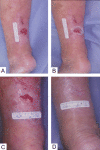OASIS wound matrix versus Hyaloskin in the treatment of difficult-to-heal wounds of mixed arterial/venous aetiology
- PMID: 17425543
- PMCID: PMC7951303
- DOI: 10.1111/j.1742-481X.2007.00300.x
OASIS wound matrix versus Hyaloskin in the treatment of difficult-to-heal wounds of mixed arterial/venous aetiology
Abstract
Mixed arterial/venous (A/V) ulcers are difficult to treat and slow to heal likely as a result of deficiencies in molecular and cellular elements in the wound bed. Recently, biomaterials have been developed that replace extracellular matrix (ECM) molecules and growth factors critical to the normal healing process. In this study, the effects of OASIS and Hyaloskin were evaluated to compare the effectiveness of these two ECM-based products in their ability to achieve complete wound healing of mixed A/V ulcers. After 16 weeks of treatment, patients in each group were evaluated on four criteria: complete wound healing, time to dressing change, pain and comfort. Complete wound closure was achieved in 82.6% of OASIS-treated ulcers compared with 46.2% of Hyaloskin-treated ulcers (P < 0.001). Statistically significant differences favouring the OASIS treatment group were also reported for time to dressing change (P < 0.05), pain (P < 0.05) and patient comfort (P < 0.01). Overall, OASIS was superior to Hyaloskin for the treatment of patients with mixed A/V ulcers, a population in which standard treatment options largely consist of moist wound dressings and compression therapy is typically not an option. OASIS is a useful and well-tolerated treatment for mixed A/V ulcers that has the potential to improve quality of life and reduce costs associated with standard of care.
Figures


Similar articles
-
Randomized comparison of OASIS wound matrix versus moist wound dressing in the treatment of difficult-to-heal wounds of mixed arterial/venous etiology.Adv Skin Wound Care. 2010 Jan;23(1):34-8. doi: 10.1097/01.ASW.0000363485.17224.26. Adv Skin Wound Care. 2010. PMID: 20101114 Clinical Trial.
-
Effectiveness of an extracellular matrix graft (OASIS Wound Matrix) in the treatment of chronic leg ulcers: a randomized clinical trial.J Vasc Surg. 2005 May;41(5):837-43. doi: 10.1016/j.jvs.2005.01.042. J Vasc Surg. 2005. PMID: 15886669 Clinical Trial.
-
[Comparison of the effectiveness and cost of treatment with humid environment as compared to traditional cure. Clinical trial on primary care patients with venous leg ulcers and pressure ulcers].Rev Enferm. 2000 Jan;23(1):17-24. Rev Enferm. 2000. PMID: 10788945 Clinical Trial. Spanish.
-
Antibiotics and antiseptics for venous leg ulcers.Cochrane Database Syst Rev. 2013 Dec 23;(12):CD003557. doi: 10.1002/14651858.CD003557.pub4. Cochrane Database Syst Rev. 2013. Update in: Cochrane Database Syst Rev. 2014 Jan 10;(1):CD003557. doi: 10.1002/14651858.CD003557.pub5. PMID: 24363048 Updated. Review.
-
Dressings for healing venous leg ulcers.Cochrane Database Syst Rev. 2006 Jul 19;(3):CD001103. doi: 10.1002/14651858.CD001103.pub2. Cochrane Database Syst Rev. 2006. Update in: Cochrane Database Syst Rev. 2014 May 06;(5):CD001103. doi: 10.1002/14651858.CD001103.pub3. PMID: 16855958 Updated. Review.
Cited by
-
Difficult-to-heal wounds of mixed arterial/venous and venous etiology: a cost-effectiveness analysis of extracellular matrix.Clinicoecon Outcomes Res. 2016 May 4;8:153-61. doi: 10.2147/CEOR.S104067. eCollection 2016. Clinicoecon Outcomes Res. 2016. PMID: 27217787 Free PMC article.
-
Use of porcine small intestine submucosa as a prosthetic material for laparoscopic hernia repair in infected and potentially contaminated fields: long-term follow-up assessment.Surg Endosc. 2011 May;25(5):1693-4. doi: 10.1007/s00464-010-1282-9. Surg Endosc. 2011. PMID: 20730448 No abstract available.
-
Dressings and topical agents containing hyaluronic acid for chronic wound healing.Cochrane Database Syst Rev. 2023 Jul 27;7(7):CD012215. doi: 10.1002/14651858.CD012215.pub2. Cochrane Database Syst Rev. 2023. PMID: 37497805 Free PMC article. Review.
-
Use of Surgisis mesh in the management of polypropylene mesh erosion into the vagina.Int Urogynecol J. 2011 Jan;22(1):41-6. doi: 10.1007/s00192-010-1234-x. Epub 2010 Aug 11. Int Urogynecol J. 2011. PMID: 20700727
-
Dermal matrices and bioengineered skin substitutes: a critical review of current options.Plast Reconstr Surg Glob Open. 2015 Feb 6;3(1):e284. doi: 10.1097/GOX.0000000000000219. eCollection 2015 Jan. Plast Reconstr Surg Glob Open. 2015. PMID: 25674365 Free PMC article.
References
-
- Treiman GS, Copland S, McNamara RM, Yellin AE, Schneider PA, Treiman RL. Factors influencing ulcer healing in patients with combined arterial and venous insufficiency. J Vasc Surg 2001;33:1158–64. - PubMed
-
- Ennis WJ, Meneses P. Standard, appropriate, and advanced care and medical‐legal considerations: Part Two – venous ulcerations. Wounds 2003;15:107–22.
-
- Ghauri AS, Nyamekye I, Grabs AJ, Farndon JR, Poskitt KR. The diagnosis and management of mixed arterial/venous leg ulcers in community‐based clinics. Eur J Vasc Endovasc Surg 1998;16:350–5. - PubMed
-
- Vijayaraghavan KS, Ayyappan MK, Ganesh S, Bhattacharya K. Chronic nonhealing ulcer of the lower limb with mixed arterio‐venous pathology. Int J Low Extrem Wounds 2004;3:47–8. - PubMed
-
- Demling RH, DeSanti L. Difficult to heal wounds. Available at: http://www.burnsurgery.org/Modules/BurnWound/rationale/healing_wounds/ov... Accessed: 7 June 2006.
Publication types
MeSH terms
LinkOut - more resources
Full Text Sources
Medical

